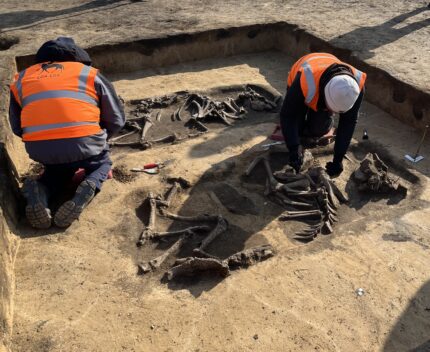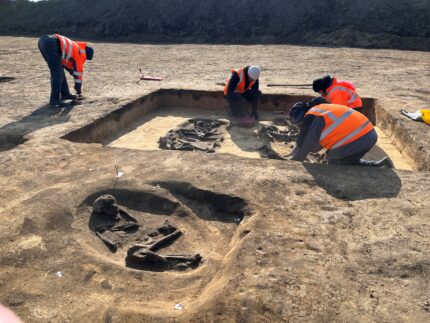 A series of Neolithic burial mounds from different periods have been discovered at Magdeburg in the eastern German state Saxony-Anhalt. The site is being excavated by the State Office for Heritage Management and Archaeology Saxony-Anhalt (LDA) before construction of two new Intel semiconductor plants. Excavations began in 2023 and are scheduled to end in April.
A series of Neolithic burial mounds from different periods have been discovered at Magdeburg in the eastern German state Saxony-Anhalt. The site is being excavated by the State Office for Heritage Management and Archaeology Saxony-Anhalt (LDA) before construction of two new Intel semiconductor plants. Excavations began in 2023 and are scheduled to end in April.
The 300 hectare large industrial park also partially includes a small hill, known as Eulenberg. Although not particularly high, it divides the otherwise relatively low-relief Börde landscape, whose fertile loess and black earth soils were an important factor for settlement already during the early Neolithic period. The area currently examined turned out to be a highly complex, long-used burial and ritual landscape.
The mounds were built by people of the Baalberg Culture (4100–3600 B.C.) approximately 6,000 years ago. They are about 200 meters (656 feet) away from each other and each contain wooden burial chambers with the remains of several people. The burial chambers are 65 feet and 98 feet long. Today the mounds are heavily eroded, but when they were first built and for many millennia afterwards, they would have dominated the landscape.
 The mounds were still a sacred site 1,000 years later. The passageway between them was used by people of the Globular Amphora Culture (3300–2800 B.C.) as a funerary procession route. The skeletal remains of young cattle were found buried in pairs along this path. They were offerings of the community’s most valuable belongings to the gods.
The mounds were still a sacred site 1,000 years later. The passageway between them was used by people of the Globular Amphora Culture (3300–2800 B.C.) as a funerary procession route. The skeletal remains of young cattle were found buried in pairs along this path. They were offerings of the community’s most valuable belongings to the gods.
Another thousand years later, the site was modified with a palisade ditch following the course of the corridor between the mounds but including the larger of the two mounds. About 600 meters (1968 feet) away a group of smaller burial mounds were built by people of the Corded Ware Culture (ca. 2800-2050 B.C.). So this one small site had ritual significance to different peoples for more than 2,000 years.